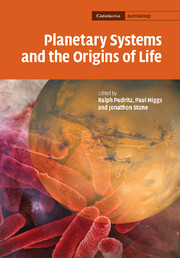Book contents
- Frontmatter
- Contents
- List of contributors
- Preface
- Part I Planetary systems and the origins of life
- Part II Life on Earth
- Part III Life in the Solar System?
- 12 The search for life on Mars
- 13 Life in the dark dune spots of Mars: a testable hypothesis
- 14 Titan: a new astrobiological vision from the Cassini–Huygens data
- 15 Europa, the ocean moon: tides, permeable ice, and life
- Index
12 - The search for life on Mars
Published online by Cambridge University Press: 13 August 2009
- Frontmatter
- Contents
- List of contributors
- Preface
- Part I Planetary systems and the origins of life
- Part II Life on Earth
- Part III Life in the Solar System?
- 12 The search for life on Mars
- 13 Life in the dark dune spots of Mars: a testable hypothesis
- 14 Titan: a new astrobiological vision from the Cassini–Huygens data
- 15 Europa, the ocean moon: tides, permeable ice, and life
- Index
Summary
Introduction
Mars is the world that has generated the most interest in life beyond the Earth. There are three reasons why Mars is the prime target for a search for signs of life. First, there is direct evidence that Mars had liquid water on its surface in the past, and there is the possibility that there is liquid water in the subsurface at the present time. Second, Mars has an atmosphere, albeit a thin one, that contains CO2 and N2. Third, conditions on Mars are cold and dry and thus are favourable for the preservation of evidence of organic remains of life that may have formed under more clement past conditions.
Mars may be cold and dry today but there is compelling evidence that earlier in its history Mars did have liquid water. This evidence comes primarily from the images taken from orbital spacecraft. Figure 12.1 from Malin and Carr (1999) shows an image of a canyon on Mars and represents probably the best evidence for extended and repeated, if not continuous, flows of liquid water on Mars.Water is the common ecological requirement for life on Earth. No organisms are known that can grow or reproduce without liquid water. Thus, the evidence that sometime in its early history Mars had liquid water is the primary motivation for the search for evidence of life (McKay, 1997).
- Type
- Chapter
- Information
- Planetary Systems and the Origins of Life , pp. 225 - 240Publisher: Cambridge University PressPrint publication year: 2007



